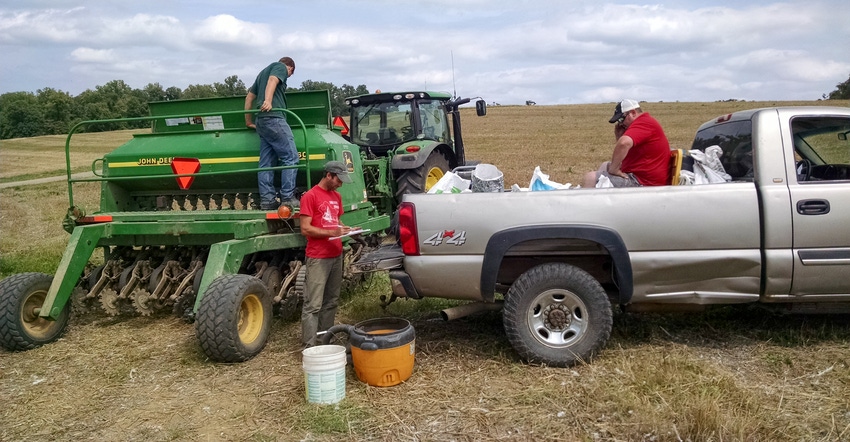June 27, 2019

Grain drills are important tools for establishing cover crops. However, since drills use flutes or sponges to meter the seed, they have been referred to as dispensing seed via “controlled spillage.”
Modern grain drills, though, do an excellent job of placing seed at a uniform depth. Seed charts provided with drills are an excellent starting point to obtain the desired seeding rate, provided you can make a comparison to similar grain settings. Keeping records of settings and planted acres for species over time helps check planned and actual seeding rates over the years.
However, new species or mixtures of species may be planted for the first time, and this makes drill calibration especially important. Other variables that affect seeding rates and may call for drill calibration are seed size and shape variations between crop varieties; seed coatings or seed treatments; and seed density (bushel weight).
Here are four steps for easy drill calibration:
1. Determine calibration area. Calibrate the drill using a driving distance of 200 feet. Also, determine the width or your drill. In this example, we will use 15 feet.
The area measured would be 3,000 square feet. When divided by 43,560 square feet (an acre) we get a calibration area of .069 acre.
2. Determine number of revolutions of drive wheel in the calibration distance. In the field, measure and mark 200 feet in length. Make a mark on the drive wheel to determine how many revolutions this wheel makes in the field in the 200-foot length. Drive 200 feet and have someone count the number of revolutions the wheel made.
3. Set up drill for calibration. Use the rate chart on the drill as a “best guess” guide and select a seed rate for a similar seed size. Make sure enough seed is in the seed box to completely cover the flutes and openings. Jack up the drive wheel so you can turn the wheel for calibration.
Make sure the drill is secure and hooked up to a tractor, so it will not be a safety hazard. Turn the drive wheel until seed starts to drop out of the openers. Now you are set to start collecting seed for calibration. Place a large tarp under the drill so all seed can be collected on the tarp.
4. Calibrate the drill. Turn the drive wheel the number of revolutions needed to represent 200 feet of travel. Collect all the seed from the tarp, then weigh and divide by the area measured in step one. Example: If we collect 1.38 pounds of seed divided by .069 acres, the calibrated seed rate is 20 pounds per acre. If seeding rate is too low or too high, open the seed meter more or less, and repeat the process until you get close to the desired seeding rate.
One final step
Field seeding rates may vary somewhat due to ground cover, soil conditions and driving speed when planting in the field. If your drill has an acre meter, keep track of the seed placed in the drill and what is used after a known amount of acres are planted. Alternatively, if acreage is known for a given field, calculate the rate in a similar fashion and fine tune as needed.
Write down the seed meter setting so you don’t have to recalibrate the next time.
If your drill has a scale and an acreage meter, some of the above steps may not be needed. Some farmers are using precision planters with special seed plates to accommodate cover crop mixes. The steps outlined above will also achieve the desired seeding rate.
The Coach’s Closer
Cover crops have a lot of benefits, but they do incur a cost. Using the correct seeding rate will further enhance their value!
Groff is a cover crop pioneer and innovator who farms in the Chesapeake Bay Watershed. Check out his website, covercropcoaching.com.
About the Author(s)
You May Also Like




